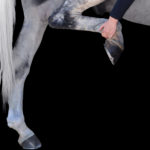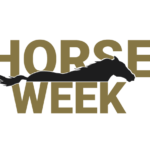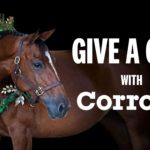April 1, 2017—Imagine taking a dressage lesson in front of thousands of people. Now imagine taking that lesson from the number one-ranked rider in the world, Isabell Werth.
Three riders had that opportunity yesterday during an innovative afternoon dubbed the Dressage Showcase, a departure from the usual competition schedule at the FEI World Cup Dressage Finals.
This hadn’t been tried at other finals, but the Omaha organizers felt dressage fans were getting shortchanged, because they had nothing geared to their interests on the day between the Grand Prix and the Freestyle. After all, those interested in show jumping could see their discipline daily during the run of their final.
The showcase included a variety of freestyles. It began with a demonstration by para-equestrian Katie Jackson, who lost her lower right leg to cancer and is strapped into the saddle on that side. But looking at her from the left, you would never know she was anything but the usual dressage rider, despite lacking a major aid. Katie was, in a word, inspiring.
 Para-equestrian champion Katie Jackson was all smiles during her performance in the Dressage Showcase.
Para-equestrian champion Katie Jackson was all smiles during her performance in the Dressage Showcase.The showcase moved on to young rider and pas de deux performances, veering off into western dressage. It was cool to see a paint son of the well-known, late quarter horse stallion, Rugged Lark, going through his moves with Florida trainer Lynn Palm. She was, of course, riding in a stock saddle, adding diversity to the presentation.
Then Tristan Tucker, an Australian who does a dressage comedy routine (I know—dressage comedy? You have to see it to believe it) put in a hilarious performance as an inept rider who talked his way through a bizarre test.
But the highlight of the afternoon was watching the way Isabell worked with horses headed for Grand Prix at various stages of their careers.
There were no airs, no jewelry, no bling. She appeared in faded jeans, a white shirt, green V-necked sweater and a quilted vest, like any of us instead of a dressage deity.
As one German acquaintance told me, “Isabell is authentic. This is what she does every day at home.”
She started with Totem, a 5-year-old chestnut by Totilas out of a Donnerhall mare, ridden by Canadian Pan Am competitor Karen Pavicic.
Isabell discussed selecting a horse as Karen circled the horse around her, saying the first things to look for in buying a prospect are “three good gaits without a big weakness.” She emphasized “high rideability with a very good mind.”
 Isabell Werth gave some interesting insights to Karen Pavicic as she rode Totem.
Isabell Werth gave some interesting insights to Karen Pavicic as she rode Totem.The horse has to show elasticity. As Karen worked with Totem, Isabell commented, “the horse needs to be free in the shoulder. The horse needs to trust her and look for the reins.”
A swinging and dynamic trot, she commented, has to come from behind; a rider improves a horse from behind, and she wants to see the horse “jump into the leg” for the canter.
Next up was the 7-year-old Lucky Strike under Endel Otts. For this horse, Isabell prescribed more bending and shoulder in, making the swing quieter and working on a smaller trot. Those who watched her warm up Wiehegold OLD, her World Cup mount, on Tuesday and Wednesday will remember the extensive collected work that she did.
She told Endel to focus on more flexion and balance.
 Isabell Werth offered a critique to Endel Otts on Lucky Strike.
Isabell Werth offered a critique to Endel Otts on Lucky Strike.“He should look for the reins,” she said of Lucky Strike; “don’t throw away the reins.” And when it came to doing flying changes, Isabell emphasized, “only a good canter can bring a good change.”
The last to appear was 8-year-old Hellohalli, ridden by U.S. Pan American Games competitor Sabine Schut-Kery. Isabell asked for lateral work, the shoulder-in and half-pass “to keep her more together so she isn’t jumping in the passage. She has to find the rhythm and then you can ask (for passage.)
 Sabine Schut-Kery on Hellohalli working with Isabell Werth during the Dressage Showcase.
Sabine Schut-Kery on Hellohalli working with Isabell Werth during the Dressage Showcase.The showcase was part of a World Cup weekend that has been heaven for fans, especially those from the Midwest, where the international dressage with “name” horses and riders so common on either coast of the country just isn’t seen.
Having the World Cup in a venue completely new to the highest end of the sport offers not only a great introduction, but for those who have been involved, a unique chance to see the best both competing and training. The idea behind hosting the Cup is to grow the sport in this region.
The warm-up ring is strategically located in the middle of the 140-vendor trade fair, making it easy for people to see what’s going on from every angle.
Jeanene Will, who owns Proud Meadows, a Dallas dressage farm, tries to come to the Cup final every time it is in the U.S. She loves standing by the warm-up arena and watching what goes on there before heading to her seat.
“It’s worth every penny,” she said.
Vendors, a bit part of the picture, are doing a lively business. Folks inspired by what they see in the arena are indulging in new bridles, saddles, boots, gimmicks, etc. And for shops selling clothing and jewelry, it’s a field day.
Jeweler Ron Raven, who appreciates having room to spread out his wares in the vast vendor area, noted “everybody has been tremendously nice.” Well, after all, Nebraska’s tourism motto is, “Visit Nebraska. Visit Nice.”
While he has merchandise in all price ranges, his high-end piece is a $40,000, 14-karat emerald necklace with diamond horse shoe accents.
“Think you’ll sell it here?” I asked.
“This is as good a chance as any,” he responded.
I’ll be putting up a postcard from the dressage freestyle tonight, so be sure to return to look for it.
Until then,







